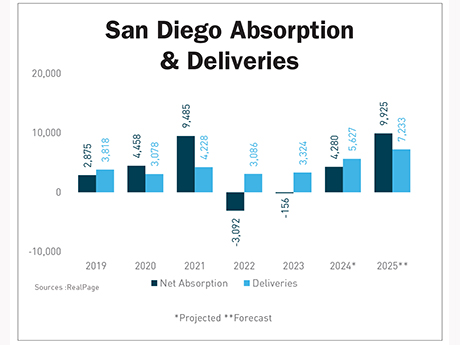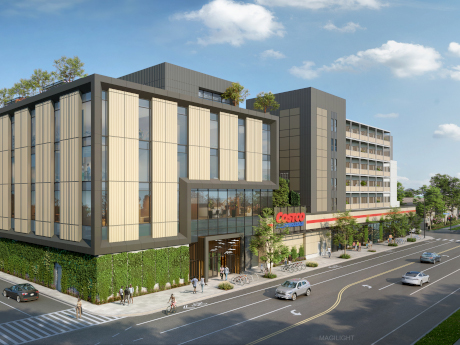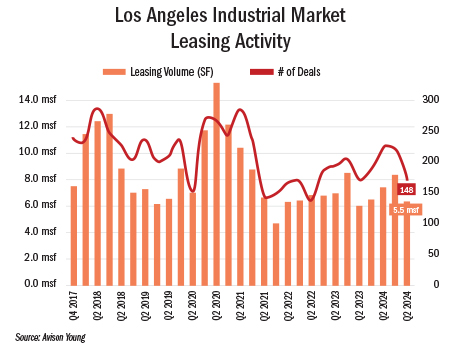— By Sebastian Bernt of Avison Young — The San Diego office market is beginning to stabilize in 2025. However, recovery remains uneven amid elevated vacancy, rising sublease availability and evolving workplace strategies. While quarterly leasing activity has improved modestly— up roughly 7 percent year over year through the second quarter — overall fundamentals remain challenged. San Diego’s total office availability rate stands at 18.2 percent as of the second quarter. This is flat from the previous quarter but still up more than 500 basis points from pre-pandemic norms. Sublease availability exceeds 2.2 million square feet, a lingering effect of corporate downsizing and the continued shift toward hybrid work models. Sublease inventory is most concentrated in suburban nodes such as UTC and Sorrento Mesa, as well as Downtown San Diego. Demand remains strongest for Class A assets in suburban submarkets like UTC, Del Mar Heights and Sorrento Valley where tenants prioritize modern, amenity-rich properties. Even within these markets, average deal sizes have declined by 20 percent to 30 percent compared to 2019 levels, with users often consolidating space and seeking shorter lease terms. Downtown San Diego continues to face pronounced headwinds, with vacancy topping 25 percent in several Class B …
Market Reports
— By Bryce Aberg and Brant Aberg of Cushman & Wakefield — Optimism is returning to the San Diego industrial market after a few quarters of recalibration. Buyer appetite has resurfaced in core submarkets like Otay Mesa, Miramar and Carlsbad, which has created a ripple effect across the Greater San Diego industrial market. With an inventory of 162 million square feet as of the second quarter, San Diego is beginning to see the benefit of limited supply. Natural barriers like Mexico, the Pacific Ocean, Camp Pendleton and the nearby mountains are driving the San Diego industrial market toward full build-out. There is currently only 2.4 million square feet of inventory under construction, with not much more proposed. Following the all-time highs in rent growth and positive absorption seen in 2021 and 2022, San Diego’s enduring fundamentals and built-in advantages have kept it in place as one of the most stable and competitive in Southern California. With a diversified tenant base, high barriers to entry and a strategic position on the U.S.-Mexico border, fundamentals have held while others in the Southern California region have struggled in comparison. Bid-ask spreads are also starting to narrow as buyer and seller sentiments begin to …
— By Berkadia — San Diego’s apartment market is poised to strengthen in 2025, with demand poised to set a record and fundamentals outperforming most other major California metros. This is a welcome change from 2024, where a slower leasing environment for Class A properties led to more concessions. The big story is demand. More than 9,900 net units are expected to be leased this year, surpassing the previous high of 9,500 in 2021. This figure will also outpace what is likely to be a record year for new deliveries, with 7,233 units slated to debut this year across the metro. By year-end, occupancy is projected to climb to 96.3 percent, up 90 basis points from 2024 and above the market’s 10-year pre-pandemic average. That puts San Diego ahead of Los Angeles, San Francisco-Oakland and San Jose on the occupancy leaderboard. Effective rent is expected to rise 3.1 percent year over year to a projected $2,868, marking a solid improvement from last year’s flat performance. Fundamentals Point to a Solid Year Employment growth remains a tailwind. The metro added 16,200 new jobs between May 2024 and May 2025, pushing total employment to nearly 1.6 million. That economic momentum is supporting …
— By Bryan Cunningham of JLL — The retail sector continues to be a bright spot for commercial real estate in San Diego County. Despite financial headwinds that include interest rates, construction costs and increases in operating costs like labor and insurance, the resiliency of the consumer has allowed retailers and restaurants to continue to generate substantial sales volumes. Both national and regional retail and restaurant tenants continue to expand, although more cautiously than in years past. Retail vacancy rates in San Diego continue to hover around 5 percent, with the more desirable coastal communities closer to 3 percent. The lack of new development due to geographical constraints, as well as interest rates and construction costs, is driving expanding tenants to look purely at second-generation retail centers. While the retail tenant pool is somewhat shallow due to bankruptcies by Bed Bath & Beyond, 99 Cents Only, Party City, JoAnn Stores and the like, the lack of new product is keeping well-positioned shopping centers in high demand. Most grocery- and big box-anchored shopping centers are enjoying rents at record levels with very little vacancy. Retail centers continue to be at the forefront of interest from investors as well. While interest rates …
— By Chris High, Steve Bruce and Conor Evans of Colliers — We’re in the middle of a market recalibration. On the office side, leasing has slowed significantly, with tenants downsizing footprints and pushing for shorter terms as hybrid work remains a dominant driver. In life sciences, we saw explosive growth from 2020 to mid-2022, but that pace has tapered off. VC funding is more selective, and some developers who stretched to convert commodity office and flex properties into lab space, often with less-than-ideal infrastructure, during the boom years, are now rethinking those strategies. Still, demand for high-quality, fitted lab space remains, especially in well-located projects by experienced owners like Longfellow, BioScience Properties, Sterling Bay, Healthpeak, BioMed, and ARE. These firms are adapting with thoughtful repositioning and delivering product that aligns with where tenant demand is today. In the near term, we expect continued headwinds. Commodity office space will face pressure on rents and absorption, while high-end life science campuses with strong sponsorship will be better positioned to attract demand. We expect Life Science to rebound in the next 12 to 18 months as capital markets settle and merger/acquisition (M&A) activity returns. Distressed office sales may continue as debt maturities …
— By Kalli Knight of Colliers — The Los Angeles multifamily market faces several headwinds, including rising expenses, the aftermath of recent fires, insurance exclusions and Measure ULA. These factors impact transaction volumes, leading many investors to remain on the sidelines. However, Southern California and Los Angeles will continue to have strong fundamentals, attracting a unique pool of buyers. This includes qualified, high-net-worth family offices eager to take advantage of limited competition to acquire new construction at prices below replacement costs or favorable debt terms. Management companies are increasingly critical in supporting property stabilization post-pandemic, with a growing urgency to enhance operations and increase net operating income. As construction loans mature, their impact on property stabilization is significant. Though the concession rate of 0.7 percent is significantly less than the national concession rate of 1.1 percent, many developers now offer four to six weeks of concessions to lease properties and meet projected rents outlined in their financial analyses. Some developers have also opted for creative strategies, such as providing customized closets to attract renters at higher luxury price points instead of relying solely on weekly concessions. Vacancy rates in the market vary, but have generally improved since 2024. They have …
— By Tony Solomon of Marcus & Millichap — The positive relationship between retailers and rooftops is proving true in key ways across Los Angeles County. The market’s retail vacancy has risen in recent years — with the metro-wide rate up 120 basis points since 2022 – but the overall measure of 6.5 percent belies strong local dynamics. Retailers are continuing to find opportunities, especially in zones with recent and upcoming residential growth. Multifamily vacancy dropped by 50 basis points or more last year in the Santa Clarita Valley, Southeast Los Angeles and the South San Gabriel Valley. These same submarkets recorded retail vacancy rates at or under 5.2 percent at the onset of this year, which are some of the lowest in the county. Property performance momentum is set to continue in those areas amid numerous upcoming move-ins, including from tenants like Savers and Planet Fitness. The growing local apartment sector is expected to help absorb the primary area of heightened availability: Downtown Los Angeles. Retail vacancy here jumped 220 basis points last year to 9.1 percent, more than 100 basis points above the next highest submarket. Thankfully, that vacancy pressure may begin to ease in the near future. …
— By Caleb Hodge of KWP Real Estate — The Los Angeles office market is undergoing a transformation. Finally. Downtown LA and most of the submarkets were decimated following the pandemic, but leasing activity is increasing. In fact, the fourth quarter of last year saw the highest annual leasing activity since the pandemic was officially declared “over,” according to Savills Research and Data Services. How is this possible? The answer lies in the evolving identity of office spaces, which is driven by the demand for creative office. Despite increased asking rates in certain submarkets, Los Angeles is still a tenant-driven office market. The rub is that hybrid-working models continue to, at times, complicate leasing decisions. Fortunately, highly sought-out creative office space in Los Angeles offers two key incentives: premium amenities and functional, innovative office designs. Creative office space may still be considered niche, but the amenities and design layouts are critical when bringing employees back to the office. In fact, those attributes are highly desired by most modern office workers, whether their industry or physical space is considered “creative” or not. With traffic being a constant factor in LA, centrally located offices with easy commutes for a majority of workers …
— By Patrick Barnes of Avison Young — The Los Angeles industrial property market has experienced increasing space availability and shifting tenant priorities over the past several quarters. Due to concerns about potential labor strikes at East and Gulf Coast ports, the anticipated surge in short-term sublease demand failed to materialize in the fourth quarter of 2024. Additionally, with a labor contract agreement reached in January, any lingering expectations that rerouted shipments would continue to bolster West Coast activity have largely dissipated. Despite a 21.7 percent year-over-year increase in TEU (twenty-foot equivalent unit) volume from 2023 to 2024, sublease availability has risen significantly as TEU tenants have either warehouse capacity or shipments leaving the region by rail. Companies today are reassessing their space needs, focusing on cost savings and operational optimization rather than expansion to deal with inflation and tariffs. Sublease space increased by 12.8 percent quarter over quarter, reaching 11.2 million square feet and pushing the overall availability rate to 9.3 percent. These changes have also led to a drop in industrial rental rates. After peaking at $1.97 per square foot in 2023, average rents have fallen 26.4 percent to $1.45 per square foot in fourth-quarter 2024. However, Class …
— By Shane Shafer of Northmarq — The Orange County apartment market is one of the most dynamic and sought-after real estate sectors in Southern California. Known for its beautiful beaches, high quality of life, and proximity to major job centers like Los Angeles and San Diego, Orange County has become a prime location for renters. As of 2025, the apartment market in the area is marked by a blend of high demand, rising rents, and an evolving landscape shaped by both economic and demographic trends. The demand for apartments in Orange County has been consistently strong in recent years. This is driven by both local and regional factors. The county’s thriving economy — bolstered by sectors like technology, healthcare, tourism and finance — provides ample job opportunities, making it an attractive place for workers from across the state and beyond. This influx of talent, combined with a relatively low housing supply, has kept rental demand high, particularly in areas near major employment hubs, such as Irvine, Costa Mesa and Anaheim. The region’s high desirability keeps apartment vacancies generally low, with occupancy rates often nearing or surpassing 95 percent. New construction, while robust, has not fully kept pace with the …
Newer Posts




